Prevalence and Clinico-Parameters of OSA in Nigeria: A Study
VerifiedAdded on 2021/02/22
|12
|3681
|283
Report
AI Summary
This report presents a literature review and proposed methodology for a study on the prevalence and clinico-parameters of obstructive sleep apnea (OSA) among hypertensive and diabetic patients in Nigeria. The literature review covers hypertension, diabetic mellitus, and OSA, including their interrelationships and associated risk factors. It highlights the high prevalence of hypertension and diabetes in Nigeria and the increasing risk of OSA due to factors like obesity. The review also discusses the impact of OSA on hypertensive and diabetic patients, including the role of snoring. The proposed methodology outlines the study area, which is Nigeria, and the study design, along with data analysis methods. The study aims to investigate the prevalence of OSA in this population, considering the significant health challenges these conditions pose in the region, and the potential for intervention to reduce the preventable burden of these diseases.
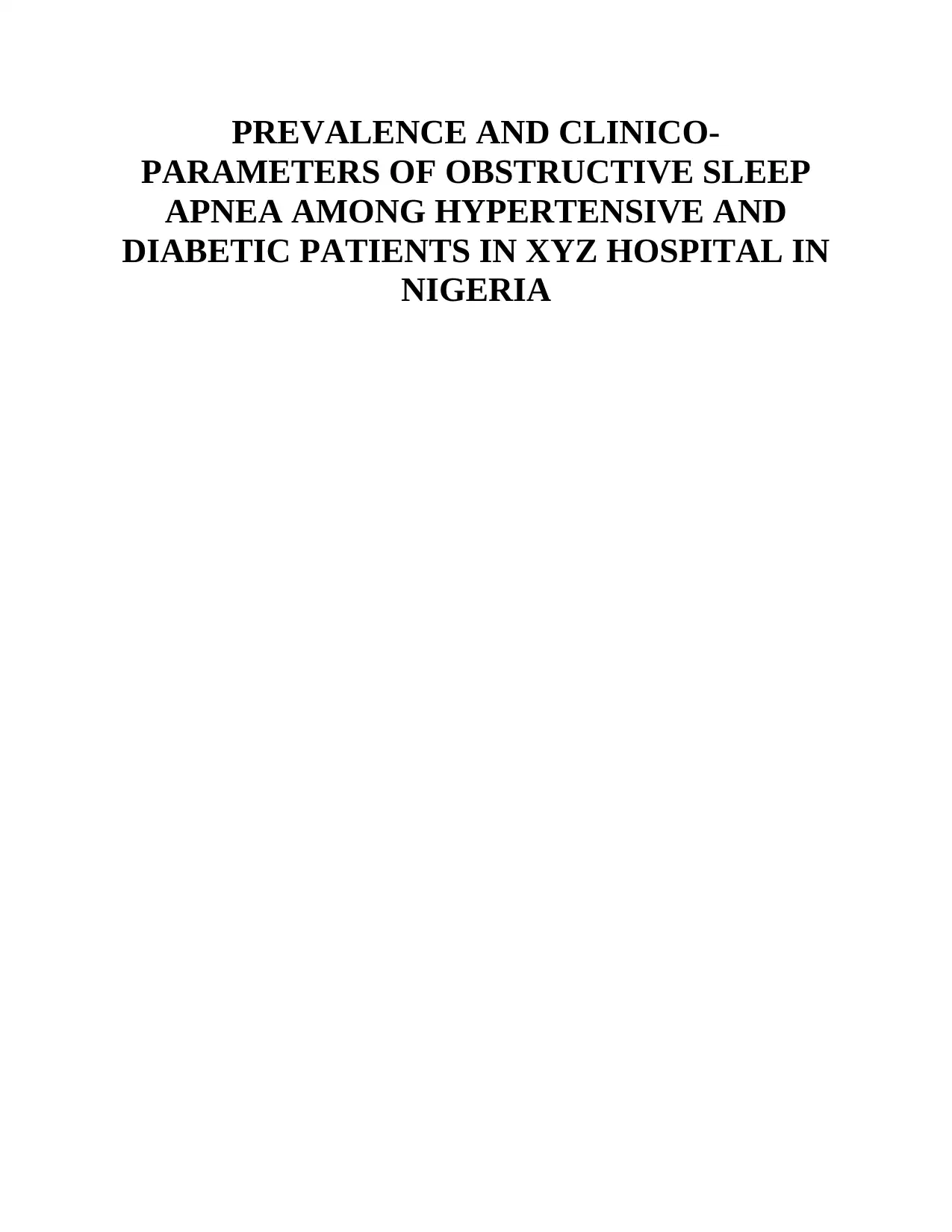
PREVALENCE AND CLINICO-
PARAMETERS OF OBSTRUCTIVE SLEEP
APNEA AMONG HYPERTENSIVE AND
DIABETIC PATIENTS IN XYZ HOSPITAL IN
NIGERIA
PARAMETERS OF OBSTRUCTIVE SLEEP
APNEA AMONG HYPERTENSIVE AND
DIABETIC PATIENTS IN XYZ HOSPITAL IN
NIGERIA
Paraphrase This Document
Need a fresh take? Get an instant paraphrase of this document with our AI Paraphraser
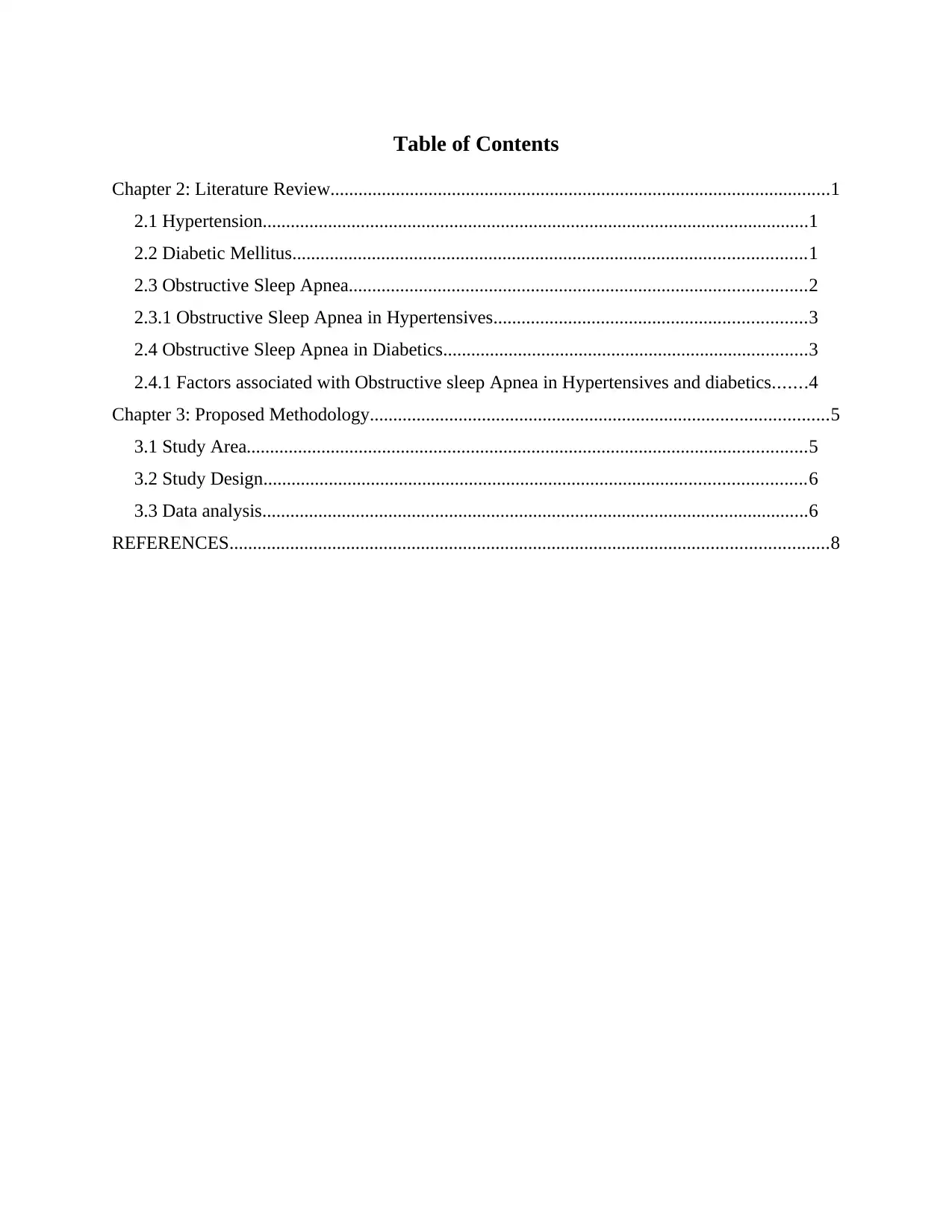
Table of Contents
Chapter 2: Literature Review...........................................................................................................1
2.1 Hypertension.....................................................................................................................1
2.2 Diabetic Mellitus..............................................................................................................1
2.3 Obstructive Sleep Apnea..................................................................................................2
2.3.1 Obstructive Sleep Apnea in Hypertensives...................................................................3
2.4 Obstructive Sleep Apnea in Diabetics..............................................................................3
2.4.1 Factors associated with Obstructive sleep Apnea in Hypertensives and diabetics.......4
Chapter 3: Proposed Methodology..................................................................................................5
3.1 Study Area........................................................................................................................5
3.2 Study Design....................................................................................................................6
3.3 Data analysis.....................................................................................................................6
REFERENCES................................................................................................................................8
Chapter 2: Literature Review...........................................................................................................1
2.1 Hypertension.....................................................................................................................1
2.2 Diabetic Mellitus..............................................................................................................1
2.3 Obstructive Sleep Apnea..................................................................................................2
2.3.1 Obstructive Sleep Apnea in Hypertensives...................................................................3
2.4 Obstructive Sleep Apnea in Diabetics..............................................................................3
2.4.1 Factors associated with Obstructive sleep Apnea in Hypertensives and diabetics.......4
Chapter 3: Proposed Methodology..................................................................................................5
3.1 Study Area........................................................................................................................5
3.2 Study Design....................................................................................................................6
3.3 Data analysis.....................................................................................................................6
REFERENCES................................................................................................................................8

⊘ This is a preview!⊘
Do you want full access?
Subscribe today to unlock all pages.

Trusted by 1+ million students worldwide

Chapter 2: Literature Review
2.1 Hypertension
According to Adeloye and et. al. (2014), it has been analysed that Hypertension refers to
be a leading cause of mortality and morbidity in Nigeria and Africa. This disease is considered as
a major risk factor for stroke and heart-issues, peripheral arterial disease, vision loss, chronic
kidney disease etc., that sometime lead to death of patient as well (An estimate of the prevalence
of hypertension in Nigeria: a systematic review and meta-analysis, 2015). Hypertension which is
also known as high-blood pressure mainly affects older-age people. It is a long-term medical
conditions whose symptoms cannot be detected earlier (Adeniyi and et. al., 2015). As per views
of William and et. al. (2017), it has been estimated that in Nigeria, which is most populated
region of Africa, Hypertension accounting for more than 52.5% of all strokes as compared with
other reason (Prevalence, awareness, and associated risk factors of hypertension in older adults
in Africa: a systematic review and meta-analysis protocol, 2017). According to World Health
Organization (WHO), African Region possess the highest age-standardized prevalence in the
world of adult hypertension, where mean BP levels (blood pressure) in black people increased
significantly from the last years (Onyenekwu, Dada and Babatunde, 2017). The reason behind
this is lack of knowledge about causes and risk associated with this disease among Nigerians and
other Africans. For this purpose, appropriate interventions are needed to be developed, for
reducing the preventable burden of hypertension at hospitals, especially at Primary Health Care
Centres, because more than 55% of the Nigerian population, in case of emergency, call such
centres first (Akanbi and et. al., 2017). As per estimation, older people have possessed higher
levels of hypertension and blood pressure. For this purpose, researches have reviewed the pooled
prevalence of this disease, which states that adults of above 65 years, are suffering 2.5 times
more than others by hypertension (Chinedu and Nicholas, 2015). These people also suffer from
other health issues due to hypertension that includes cognitive impairment, obesity and diabetes.
2.2 Diabetic Mellitus
Diabetic Mellitus (DM) is the Type 2 diabetes which is chronic and debilitating disease
and mainly characterised by impaired insulin secretion, insulin resistance and hyperglycemia
(Danmusa and et. al., 2016). It causes in old-age generally, but can causes by genetically also i.e.
from parents to their offerings, as well as people having obesity-related problems. According to
1
2.1 Hypertension
According to Adeloye and et. al. (2014), it has been analysed that Hypertension refers to
be a leading cause of mortality and morbidity in Nigeria and Africa. This disease is considered as
a major risk factor for stroke and heart-issues, peripheral arterial disease, vision loss, chronic
kidney disease etc., that sometime lead to death of patient as well (An estimate of the prevalence
of hypertension in Nigeria: a systematic review and meta-analysis, 2015). Hypertension which is
also known as high-blood pressure mainly affects older-age people. It is a long-term medical
conditions whose symptoms cannot be detected earlier (Adeniyi and et. al., 2015). As per views
of William and et. al. (2017), it has been estimated that in Nigeria, which is most populated
region of Africa, Hypertension accounting for more than 52.5% of all strokes as compared with
other reason (Prevalence, awareness, and associated risk factors of hypertension in older adults
in Africa: a systematic review and meta-analysis protocol, 2017). According to World Health
Organization (WHO), African Region possess the highest age-standardized prevalence in the
world of adult hypertension, where mean BP levels (blood pressure) in black people increased
significantly from the last years (Onyenekwu, Dada and Babatunde, 2017). The reason behind
this is lack of knowledge about causes and risk associated with this disease among Nigerians and
other Africans. For this purpose, appropriate interventions are needed to be developed, for
reducing the preventable burden of hypertension at hospitals, especially at Primary Health Care
Centres, because more than 55% of the Nigerian population, in case of emergency, call such
centres first (Akanbi and et. al., 2017). As per estimation, older people have possessed higher
levels of hypertension and blood pressure. For this purpose, researches have reviewed the pooled
prevalence of this disease, which states that adults of above 65 years, are suffering 2.5 times
more than others by hypertension (Chinedu and Nicholas, 2015). These people also suffer from
other health issues due to hypertension that includes cognitive impairment, obesity and diabetes.
2.2 Diabetic Mellitus
Diabetic Mellitus (DM) is the Type 2 diabetes which is chronic and debilitating disease
and mainly characterised by impaired insulin secretion, insulin resistance and hyperglycemia
(Danmusa and et. al., 2016). It causes in old-age generally, but can causes by genetically also i.e.
from parents to their offerings, as well as people having obesity-related problems. According to
1
Paraphrase This Document
Need a fresh take? Get an instant paraphrase of this document with our AI Paraphraser

Anthonia and Chukwuma (2014), it has been analysed that diabetes mellitus refers to a diverse
group of metabolic disorders, which is generally associated with a high disease burden in Africa and
Nigeria. In early period, residents of this region haven't much information about Diabetic Mellitus
(Dahiru, Aliyu and Shehu, 2016). They though that is was a “curses” or “hexes” and can only be
diagnosed by blood or urinary tests that check level of glucose (Diabetes mellitus in Nigeria: The
past, present and future, 2014). But now, treatments procedures of DM in Nigeria includes the
administration of insulin; proper diet-chart plan for reducing obesity-related problems that
contributes the diabetes and life-style modifications; and more. It has been observed by researchers’
point of view that the prevalence of diabetic mellitus is increased with advancing age, because age is
accompanied through decline in lean body mass, that increases fat in body and causes obesity (Iloh,
Amadi and Ebirim, 2015). Ageing also causes visceral adiposity, which is considered as the main
contributed factor for development of insulin resistance. Therefore, advancing age also result in
inducing the decrease of insulin sensitivity, that inadequately response the β-cell of functional mass
in case of insulin resistance. So, it is essential for people especially of Nigeria who are at higher risk
of diabetes, to take prevention with increase in age (Bosu, 2016). Similarly, prevalence of DM is
also high among those people who are overweight and having high BMI (Body Mass Index) that
increases retinol-binding protein 4, production of cytokines and more. These causes reduction in
level of adiponectin and contribute for insulin resistance in body. Increasing weight also lead to
cause hypertension that causes a number of issues, so, it is essential for healthcare organisation to
bring awareness among people about how obesity will cause such a serve issues, within their body
like Diabetic Mellitus and Hypertension (Okoduwa and et. al., 2015).
2.3 Obstructive Sleep Apnea
Obstructive Sleep Apnea (OSA) refers to a common sleep disorder and characterised by
repetitive occurrences of nocturnal breathing cessation in human due to upper airway collapse
(Okoduwa and et. al., 2015). It causes a number of symptoms, that includes excessive daytime
somnolence as well as associated with cardiovascular mortality and morbidity, in a significant
manner (Zanchetti, 2015). In context with Nigeria, increasing people having obesity, consider the
main risk factor that causes this type of sleeping disorder. Other risk factors that causes OSA in
Nigerians and other Africans include alcohol consumption, cigarette smoking, age factor, male
sex and hormones indifference (Dahiru, Aliyu and Shehu, 2016). Therefore, OSA causes a
negative impact on quality of life and reduces life-expectancy as well. Along with this, it also
2
group of metabolic disorders, which is generally associated with a high disease burden in Africa and
Nigeria. In early period, residents of this region haven't much information about Diabetic Mellitus
(Dahiru, Aliyu and Shehu, 2016). They though that is was a “curses” or “hexes” and can only be
diagnosed by blood or urinary tests that check level of glucose (Diabetes mellitus in Nigeria: The
past, present and future, 2014). But now, treatments procedures of DM in Nigeria includes the
administration of insulin; proper diet-chart plan for reducing obesity-related problems that
contributes the diabetes and life-style modifications; and more. It has been observed by researchers’
point of view that the prevalence of diabetic mellitus is increased with advancing age, because age is
accompanied through decline in lean body mass, that increases fat in body and causes obesity (Iloh,
Amadi and Ebirim, 2015). Ageing also causes visceral adiposity, which is considered as the main
contributed factor for development of insulin resistance. Therefore, advancing age also result in
inducing the decrease of insulin sensitivity, that inadequately response the β-cell of functional mass
in case of insulin resistance. So, it is essential for people especially of Nigeria who are at higher risk
of diabetes, to take prevention with increase in age (Bosu, 2016). Similarly, prevalence of DM is
also high among those people who are overweight and having high BMI (Body Mass Index) that
increases retinol-binding protein 4, production of cytokines and more. These causes reduction in
level of adiponectin and contribute for insulin resistance in body. Increasing weight also lead to
cause hypertension that causes a number of issues, so, it is essential for healthcare organisation to
bring awareness among people about how obesity will cause such a serve issues, within their body
like Diabetic Mellitus and Hypertension (Okoduwa and et. al., 2015).
2.3 Obstructive Sleep Apnea
Obstructive Sleep Apnea (OSA) refers to a common sleep disorder and characterised by
repetitive occurrences of nocturnal breathing cessation in human due to upper airway collapse
(Okoduwa and et. al., 2015). It causes a number of symptoms, that includes excessive daytime
somnolence as well as associated with cardiovascular mortality and morbidity, in a significant
manner (Zanchetti, 2015). In context with Nigeria, increasing people having obesity, consider the
main risk factor that causes this type of sleeping disorder. Other risk factors that causes OSA in
Nigerians and other Africans include alcohol consumption, cigarette smoking, age factor, male
sex and hormones indifference (Dahiru, Aliyu and Shehu, 2016). Therefore, OSA causes a
negative impact on quality of life and reduces life-expectancy as well. Along with this, it also
2
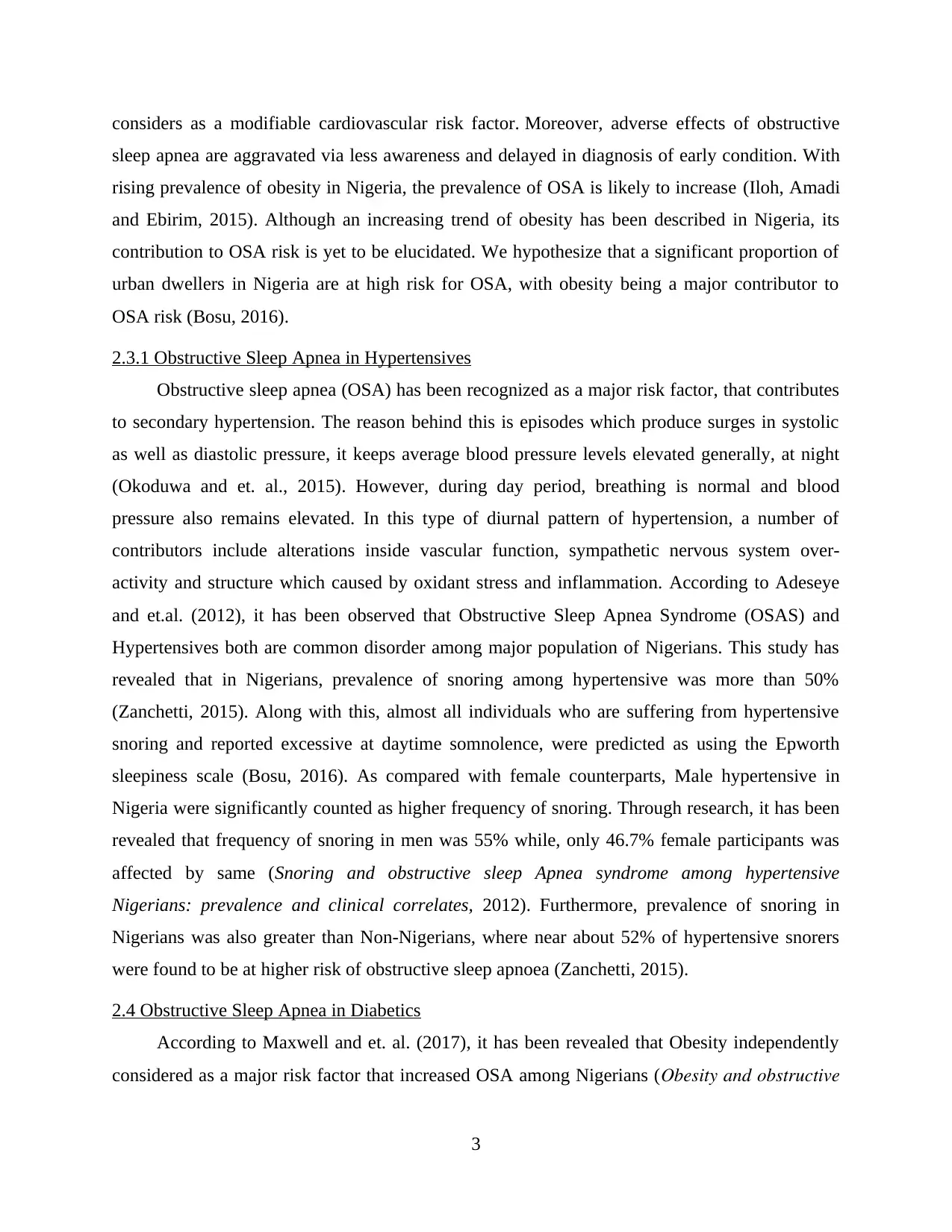
considers as a modifiable cardiovascular risk factor. Moreover, adverse effects of obstructive
sleep apnea are aggravated via less awareness and delayed in diagnosis of early condition. With
rising prevalence of obesity in Nigeria, the prevalence of OSA is likely to increase (Iloh, Amadi
and Ebirim, 2015). Although an increasing trend of obesity has been described in Nigeria, its
contribution to OSA risk is yet to be elucidated. We hypothesize that a significant proportion of
urban dwellers in Nigeria are at high risk for OSA, with obesity being a major contributor to
OSA risk (Bosu, 2016).
2.3.1 Obstructive Sleep Apnea in Hypertensives
Obstructive sleep apnea (OSA) has been recognized as a major risk factor, that contributes
to secondary hypertension. The reason behind this is episodes which produce surges in systolic
as well as diastolic pressure, it keeps average blood pressure levels elevated generally, at night
(Okoduwa and et. al., 2015). However, during day period, breathing is normal and blood
pressure also remains elevated. In this type of diurnal pattern of hypertension, a number of
contributors include alterations inside vascular function, sympathetic nervous system over-
activity and structure which caused by oxidant stress and inflammation. According to Adeseye
and et.al. (2012), it has been observed that Obstructive Sleep Apnea Syndrome (OSAS) and
Hypertensives both are common disorder among major population of Nigerians. This study has
revealed that in Nigerians, prevalence of snoring among hypertensive was more than 50%
(Zanchetti, 2015). Along with this, almost all individuals who are suffering from hypertensive
snoring and reported excessive at daytime somnolence, were predicted as using the Epworth
sleepiness scale (Bosu, 2016). As compared with female counterparts, Male hypertensive in
Nigeria were significantly counted as higher frequency of snoring. Through research, it has been
revealed that frequency of snoring in men was 55% while, only 46.7% female participants was
affected by same (Snoring and obstructive sleep Apnea syndrome among hypertensive
Nigerians: prevalence and clinical correlates, 2012). Furthermore, prevalence of snoring in
Nigerians was also greater than Non-Nigerians, where near about 52% of hypertensive snorers
were found to be at higher risk of obstructive sleep apnoea (Zanchetti, 2015).
2.4 Obstructive Sleep Apnea in Diabetics
According to Maxwell and et. al. (2017), it has been revealed that Obesity independently
considered as a major risk factor that increased OSA among Nigerians (Obesity and obstructive
3
sleep apnea are aggravated via less awareness and delayed in diagnosis of early condition. With
rising prevalence of obesity in Nigeria, the prevalence of OSA is likely to increase (Iloh, Amadi
and Ebirim, 2015). Although an increasing trend of obesity has been described in Nigeria, its
contribution to OSA risk is yet to be elucidated. We hypothesize that a significant proportion of
urban dwellers in Nigeria are at high risk for OSA, with obesity being a major contributor to
OSA risk (Bosu, 2016).
2.3.1 Obstructive Sleep Apnea in Hypertensives
Obstructive sleep apnea (OSA) has been recognized as a major risk factor, that contributes
to secondary hypertension. The reason behind this is episodes which produce surges in systolic
as well as diastolic pressure, it keeps average blood pressure levels elevated generally, at night
(Okoduwa and et. al., 2015). However, during day period, breathing is normal and blood
pressure also remains elevated. In this type of diurnal pattern of hypertension, a number of
contributors include alterations inside vascular function, sympathetic nervous system over-
activity and structure which caused by oxidant stress and inflammation. According to Adeseye
and et.al. (2012), it has been observed that Obstructive Sleep Apnea Syndrome (OSAS) and
Hypertensives both are common disorder among major population of Nigerians. This study has
revealed that in Nigerians, prevalence of snoring among hypertensive was more than 50%
(Zanchetti, 2015). Along with this, almost all individuals who are suffering from hypertensive
snoring and reported excessive at daytime somnolence, were predicted as using the Epworth
sleepiness scale (Bosu, 2016). As compared with female counterparts, Male hypertensive in
Nigeria were significantly counted as higher frequency of snoring. Through research, it has been
revealed that frequency of snoring in men was 55% while, only 46.7% female participants was
affected by same (Snoring and obstructive sleep Apnea syndrome among hypertensive
Nigerians: prevalence and clinical correlates, 2012). Furthermore, prevalence of snoring in
Nigerians was also greater than Non-Nigerians, where near about 52% of hypertensive snorers
were found to be at higher risk of obstructive sleep apnoea (Zanchetti, 2015).
2.4 Obstructive Sleep Apnea in Diabetics
According to Maxwell and et. al. (2017), it has been revealed that Obesity independently
considered as a major risk factor that increased OSA among Nigerians (Obesity and obstructive
3
⊘ This is a preview!⊘
Do you want full access?
Subscribe today to unlock all pages.

Trusted by 1+ million students worldwide
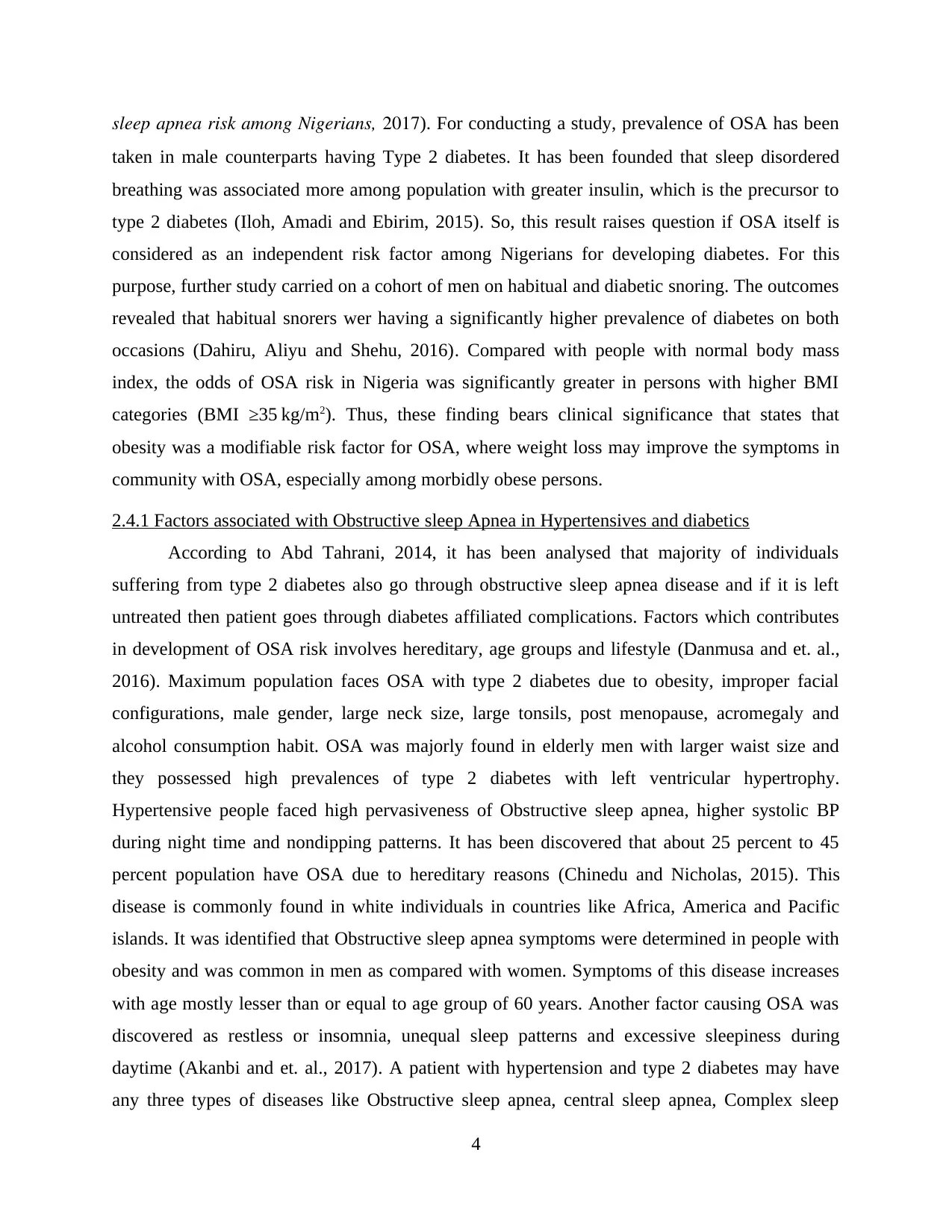
sleep apnea risk among Nigerians, 2017). For conducting a study, prevalence of OSA has been
taken in male counterparts having Type 2 diabetes. It has been founded that sleep disordered
breathing was associated more among population with greater insulin, which is the precursor to
type 2 diabetes (Iloh, Amadi and Ebirim, 2015). So, this result raises question if OSA itself is
considered as an independent risk factor among Nigerians for developing diabetes. For this
purpose, further study carried on a cohort of men on habitual and diabetic snoring. The outcomes
revealed that habitual snorers wer having a significantly higher prevalence of diabetes on both
occasions (Dahiru, Aliyu and Shehu, 2016). Compared with people with normal body mass
index, the odds of OSA risk in Nigeria was significantly greater in persons with higher BMI
categories (BMI ≥35 kg/m2). Thus, these finding bears clinical significance that states that
obesity was a modifiable risk factor for OSA, where weight loss may improve the symptoms in
community with OSA, especially among morbidly obese persons.
2.4.1 Factors associated with Obstructive sleep Apnea in Hypertensives and diabetics
According to Abd Tahrani, 2014, it has been analysed that majority of individuals
suffering from type 2 diabetes also go through obstructive sleep apnea disease and if it is left
untreated then patient goes through diabetes affiliated complications. Factors which contributes
in development of OSA risk involves hereditary, age groups and lifestyle (Danmusa and et. al.,
2016). Maximum population faces OSA with type 2 diabetes due to obesity, improper facial
configurations, male gender, large neck size, large tonsils, post menopause, acromegaly and
alcohol consumption habit. OSA was majorly found in elderly men with larger waist size and
they possessed high prevalences of type 2 diabetes with left ventricular hypertrophy.
Hypertensive people faced high pervasiveness of Obstructive sleep apnea, higher systolic BP
during night time and nondipping patterns. It has been discovered that about 25 percent to 45
percent population have OSA due to hereditary reasons (Chinedu and Nicholas, 2015). This
disease is commonly found in white individuals in countries like Africa, America and Pacific
islands. It was identified that Obstructive sleep apnea symptoms were determined in people with
obesity and was common in men as compared with women. Symptoms of this disease increases
with age mostly lesser than or equal to age group of 60 years. Another factor causing OSA was
discovered as restless or insomnia, unequal sleep patterns and excessive sleepiness during
daytime (Akanbi and et. al., 2017). A patient with hypertension and type 2 diabetes may have
any three types of diseases like Obstructive sleep apnea, central sleep apnea, Complex sleep
4
taken in male counterparts having Type 2 diabetes. It has been founded that sleep disordered
breathing was associated more among population with greater insulin, which is the precursor to
type 2 diabetes (Iloh, Amadi and Ebirim, 2015). So, this result raises question if OSA itself is
considered as an independent risk factor among Nigerians for developing diabetes. For this
purpose, further study carried on a cohort of men on habitual and diabetic snoring. The outcomes
revealed that habitual snorers wer having a significantly higher prevalence of diabetes on both
occasions (Dahiru, Aliyu and Shehu, 2016). Compared with people with normal body mass
index, the odds of OSA risk in Nigeria was significantly greater in persons with higher BMI
categories (BMI ≥35 kg/m2). Thus, these finding bears clinical significance that states that
obesity was a modifiable risk factor for OSA, where weight loss may improve the symptoms in
community with OSA, especially among morbidly obese persons.
2.4.1 Factors associated with Obstructive sleep Apnea in Hypertensives and diabetics
According to Abd Tahrani, 2014, it has been analysed that majority of individuals
suffering from type 2 diabetes also go through obstructive sleep apnea disease and if it is left
untreated then patient goes through diabetes affiliated complications. Factors which contributes
in development of OSA risk involves hereditary, age groups and lifestyle (Danmusa and et. al.,
2016). Maximum population faces OSA with type 2 diabetes due to obesity, improper facial
configurations, male gender, large neck size, large tonsils, post menopause, acromegaly and
alcohol consumption habit. OSA was majorly found in elderly men with larger waist size and
they possessed high prevalences of type 2 diabetes with left ventricular hypertrophy.
Hypertensive people faced high pervasiveness of Obstructive sleep apnea, higher systolic BP
during night time and nondipping patterns. It has been discovered that about 25 percent to 45
percent population have OSA due to hereditary reasons (Chinedu and Nicholas, 2015). This
disease is commonly found in white individuals in countries like Africa, America and Pacific
islands. It was identified that Obstructive sleep apnea symptoms were determined in people with
obesity and was common in men as compared with women. Symptoms of this disease increases
with age mostly lesser than or equal to age group of 60 years. Another factor causing OSA was
discovered as restless or insomnia, unequal sleep patterns and excessive sleepiness during
daytime (Akanbi and et. al., 2017). A patient with hypertension and type 2 diabetes may have
any three types of diseases like Obstructive sleep apnea, central sleep apnea, Complex sleep
4
Paraphrase This Document
Need a fresh take? Get an instant paraphrase of this document with our AI Paraphraser
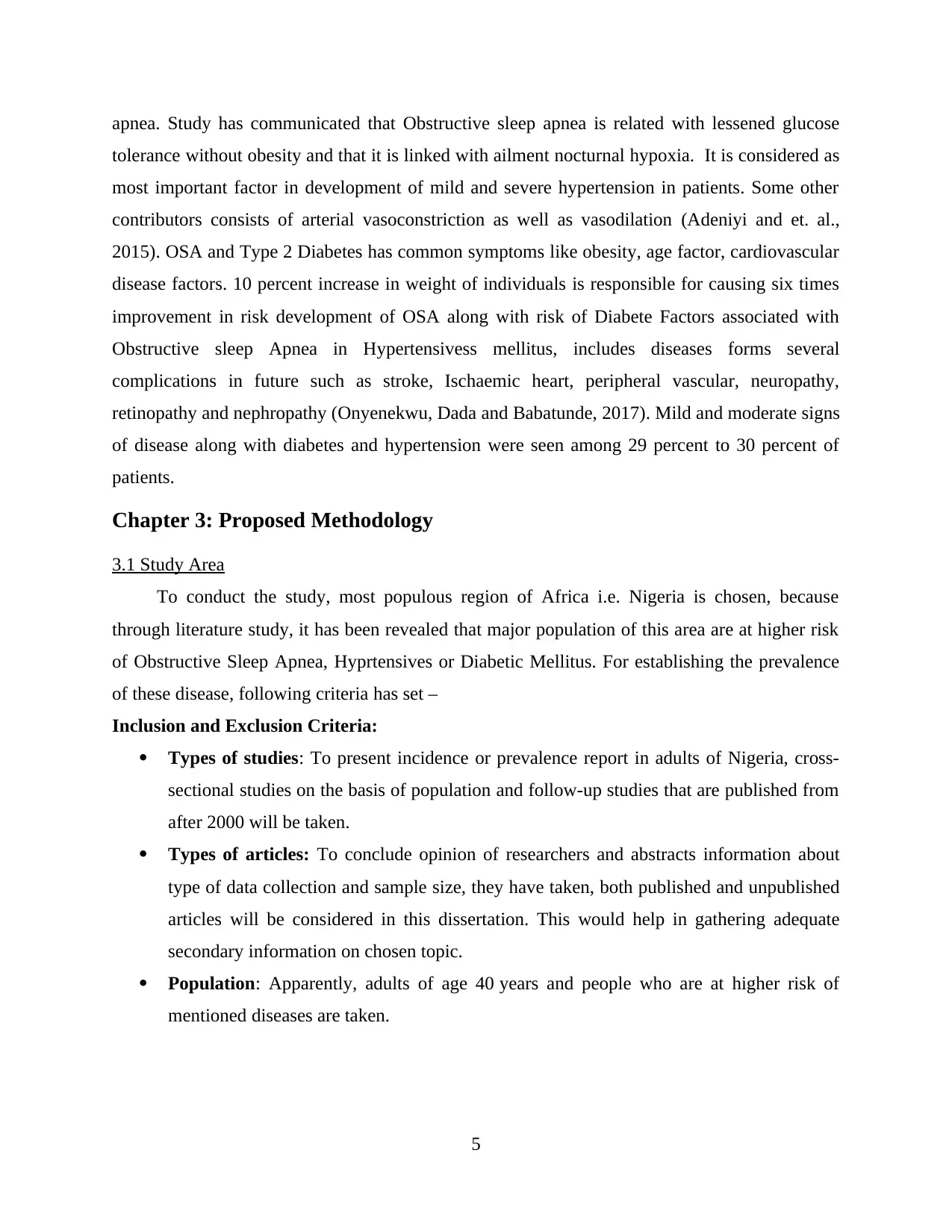
apnea. Study has communicated that Obstructive sleep apnea is related with lessened glucose
tolerance without obesity and that it is linked with ailment nocturnal hypoxia. It is considered as
most important factor in development of mild and severe hypertension in patients. Some other
contributors consists of arterial vasoconstriction as well as vasodilation (Adeniyi and et. al.,
2015). OSA and Type 2 Diabetes has common symptoms like obesity, age factor, cardiovascular
disease factors. 10 percent increase in weight of individuals is responsible for causing six times
improvement in risk development of OSA along with risk of Diabete Factors associated with
Obstructive sleep Apnea in Hypertensivess mellitus, includes diseases forms several
complications in future such as stroke, Ischaemic heart, peripheral vascular, neuropathy,
retinopathy and nephropathy (Onyenekwu, Dada and Babatunde, 2017). Mild and moderate signs
of disease along with diabetes and hypertension were seen among 29 percent to 30 percent of
patients.
Chapter 3: Proposed Methodology
3.1 Study Area
To conduct the study, most populous region of Africa i.e. Nigeria is chosen, because
through literature study, it has been revealed that major population of this area are at higher risk
of Obstructive Sleep Apnea, Hyprtensives or Diabetic Mellitus. For establishing the prevalence
of these disease, following criteria has set –
Inclusion and Exclusion Criteria:
Types of studies: To present incidence or prevalence report in adults of Nigeria, cross-
sectional studies on the basis of population and follow-up studies that are published from
after 2000 will be taken.
Types of articles: To conclude opinion of researchers and abstracts information about
type of data collection and sample size, they have taken, both published and unpublished
articles will be considered in this dissertation. This would help in gathering adequate
secondary information on chosen topic.
Population: Apparently, adults of age 40 years and people who are at higher risk of
mentioned diseases are taken.
5
tolerance without obesity and that it is linked with ailment nocturnal hypoxia. It is considered as
most important factor in development of mild and severe hypertension in patients. Some other
contributors consists of arterial vasoconstriction as well as vasodilation (Adeniyi and et. al.,
2015). OSA and Type 2 Diabetes has common symptoms like obesity, age factor, cardiovascular
disease factors. 10 percent increase in weight of individuals is responsible for causing six times
improvement in risk development of OSA along with risk of Diabete Factors associated with
Obstructive sleep Apnea in Hypertensivess mellitus, includes diseases forms several
complications in future such as stroke, Ischaemic heart, peripheral vascular, neuropathy,
retinopathy and nephropathy (Onyenekwu, Dada and Babatunde, 2017). Mild and moderate signs
of disease along with diabetes and hypertension were seen among 29 percent to 30 percent of
patients.
Chapter 3: Proposed Methodology
3.1 Study Area
To conduct the study, most populous region of Africa i.e. Nigeria is chosen, because
through literature study, it has been revealed that major population of this area are at higher risk
of Obstructive Sleep Apnea, Hyprtensives or Diabetic Mellitus. For establishing the prevalence
of these disease, following criteria has set –
Inclusion and Exclusion Criteria:
Types of studies: To present incidence or prevalence report in adults of Nigeria, cross-
sectional studies on the basis of population and follow-up studies that are published from
after 2000 will be taken.
Types of articles: To conclude opinion of researchers and abstracts information about
type of data collection and sample size, they have taken, both published and unpublished
articles will be considered in this dissertation. This would help in gathering adequate
secondary information on chosen topic.
Population: Apparently, adults of age 40 years and people who are at higher risk of
mentioned diseases are taken.
5
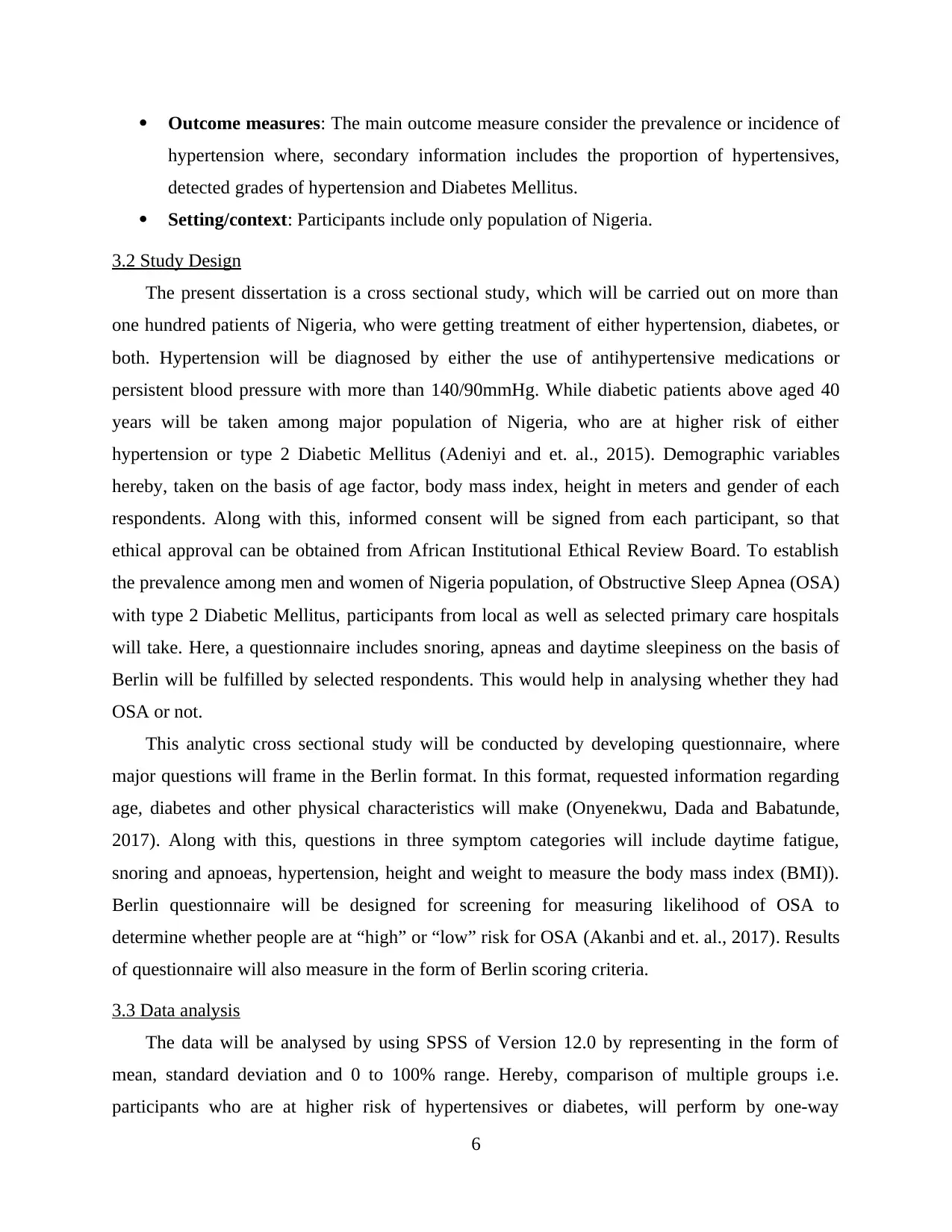
Outcome measures: The main outcome measure consider the prevalence or incidence of
hypertension where, secondary information includes the proportion of hypertensives,
detected grades of hypertension and Diabetes Mellitus.
Setting/context: Participants include only population of Nigeria.
3.2 Study Design
The present dissertation is a cross sectional study, which will be carried out on more than
one hundred patients of Nigeria, who were getting treatment of either hypertension, diabetes, or
both. Hypertension will be diagnosed by either the use of antihypertensive medications or
persistent blood pressure with more than 140/90mmHg. While diabetic patients above aged 40
years will be taken among major population of Nigeria, who are at higher risk of either
hypertension or type 2 Diabetic Mellitus (Adeniyi and et. al., 2015). Demographic variables
hereby, taken on the basis of age factor, body mass index, height in meters and gender of each
respondents. Along with this, informed consent will be signed from each participant, so that
ethical approval can be obtained from African Institutional Ethical Review Board. To establish
the prevalence among men and women of Nigeria population, of Obstructive Sleep Apnea (OSA)
with type 2 Diabetic Mellitus, participants from local as well as selected primary care hospitals
will take. Here, a questionnaire includes snoring, apneas and daytime sleepiness on the basis of
Berlin will be fulfilled by selected respondents. This would help in analysing whether they had
OSA or not.
This analytic cross sectional study will be conducted by developing questionnaire, where
major questions will frame in the Berlin format. In this format, requested information regarding
age, diabetes and other physical characteristics will make (Onyenekwu, Dada and Babatunde,
2017). Along with this, questions in three symptom categories will include daytime fatigue,
snoring and apnoeas, hypertension, height and weight to measure the body mass index (BMI)).
Berlin questionnaire will be designed for screening for measuring likelihood of OSA to
determine whether people are at “high” or “low” risk for OSA (Akanbi and et. al., 2017). Results
of questionnaire will also measure in the form of Berlin scoring criteria.
3.3 Data analysis
The data will be analysed by using SPSS of Version 12.0 by representing in the form of
mean, standard deviation and 0 to 100% range. Hereby, comparison of multiple groups i.e.
participants who are at higher risk of hypertensives or diabetes, will perform by one-way
6
hypertension where, secondary information includes the proportion of hypertensives,
detected grades of hypertension and Diabetes Mellitus.
Setting/context: Participants include only population of Nigeria.
3.2 Study Design
The present dissertation is a cross sectional study, which will be carried out on more than
one hundred patients of Nigeria, who were getting treatment of either hypertension, diabetes, or
both. Hypertension will be diagnosed by either the use of antihypertensive medications or
persistent blood pressure with more than 140/90mmHg. While diabetic patients above aged 40
years will be taken among major population of Nigeria, who are at higher risk of either
hypertension or type 2 Diabetic Mellitus (Adeniyi and et. al., 2015). Demographic variables
hereby, taken on the basis of age factor, body mass index, height in meters and gender of each
respondents. Along with this, informed consent will be signed from each participant, so that
ethical approval can be obtained from African Institutional Ethical Review Board. To establish
the prevalence among men and women of Nigeria population, of Obstructive Sleep Apnea (OSA)
with type 2 Diabetic Mellitus, participants from local as well as selected primary care hospitals
will take. Here, a questionnaire includes snoring, apneas and daytime sleepiness on the basis of
Berlin will be fulfilled by selected respondents. This would help in analysing whether they had
OSA or not.
This analytic cross sectional study will be conducted by developing questionnaire, where
major questions will frame in the Berlin format. In this format, requested information regarding
age, diabetes and other physical characteristics will make (Onyenekwu, Dada and Babatunde,
2017). Along with this, questions in three symptom categories will include daytime fatigue,
snoring and apnoeas, hypertension, height and weight to measure the body mass index (BMI)).
Berlin questionnaire will be designed for screening for measuring likelihood of OSA to
determine whether people are at “high” or “low” risk for OSA (Akanbi and et. al., 2017). Results
of questionnaire will also measure in the form of Berlin scoring criteria.
3.3 Data analysis
The data will be analysed by using SPSS of Version 12.0 by representing in the form of
mean, standard deviation and 0 to 100% range. Hereby, comparison of multiple groups i.e.
participants who are at higher risk of hypertensives or diabetes, will perform by one-way
6
⊘ This is a preview!⊘
Do you want full access?
Subscribe today to unlock all pages.

Trusted by 1+ million students worldwide

ANNOVA (analysis of variance). Along with this, differences among “high” and “low” risk
groups will assess by using χ2 and unpaired t tests. The characteristics of selected participants of
Nigeria will be summarised in tables by using descriptive statistics, where main outcomes are
hypertension, diabetic mellitus and obstructive sleep apnea. The strength of this cross sectional
study between various demographic, lifestyle and socio-economic factors in bivariate and
multivariable analysis will be reported. Along with this, protocol will be presented a
comprehensive as well as reproducible approach, for systematically estimating the prevalence of
hypertension within adult population of Nigeria. This would help in conforming the best
practices at each stage of the protocol development in order to assure high-quality output. It is
expected that the findings of the systematic review would galvanize national and regional efforts
to improve the cardiovascular health of this often-neglected population in Africa.
7
groups will assess by using χ2 and unpaired t tests. The characteristics of selected participants of
Nigeria will be summarised in tables by using descriptive statistics, where main outcomes are
hypertension, diabetic mellitus and obstructive sleep apnea. The strength of this cross sectional
study between various demographic, lifestyle and socio-economic factors in bivariate and
multivariable analysis will be reported. Along with this, protocol will be presented a
comprehensive as well as reproducible approach, for systematically estimating the prevalence of
hypertension within adult population of Nigeria. This would help in conforming the best
practices at each stage of the protocol development in order to assure high-quality output. It is
expected that the findings of the systematic review would galvanize national and regional efforts
to improve the cardiovascular health of this often-neglected population in Africa.
7
Paraphrase This Document
Need a fresh take? Get an instant paraphrase of this document with our AI Paraphraser
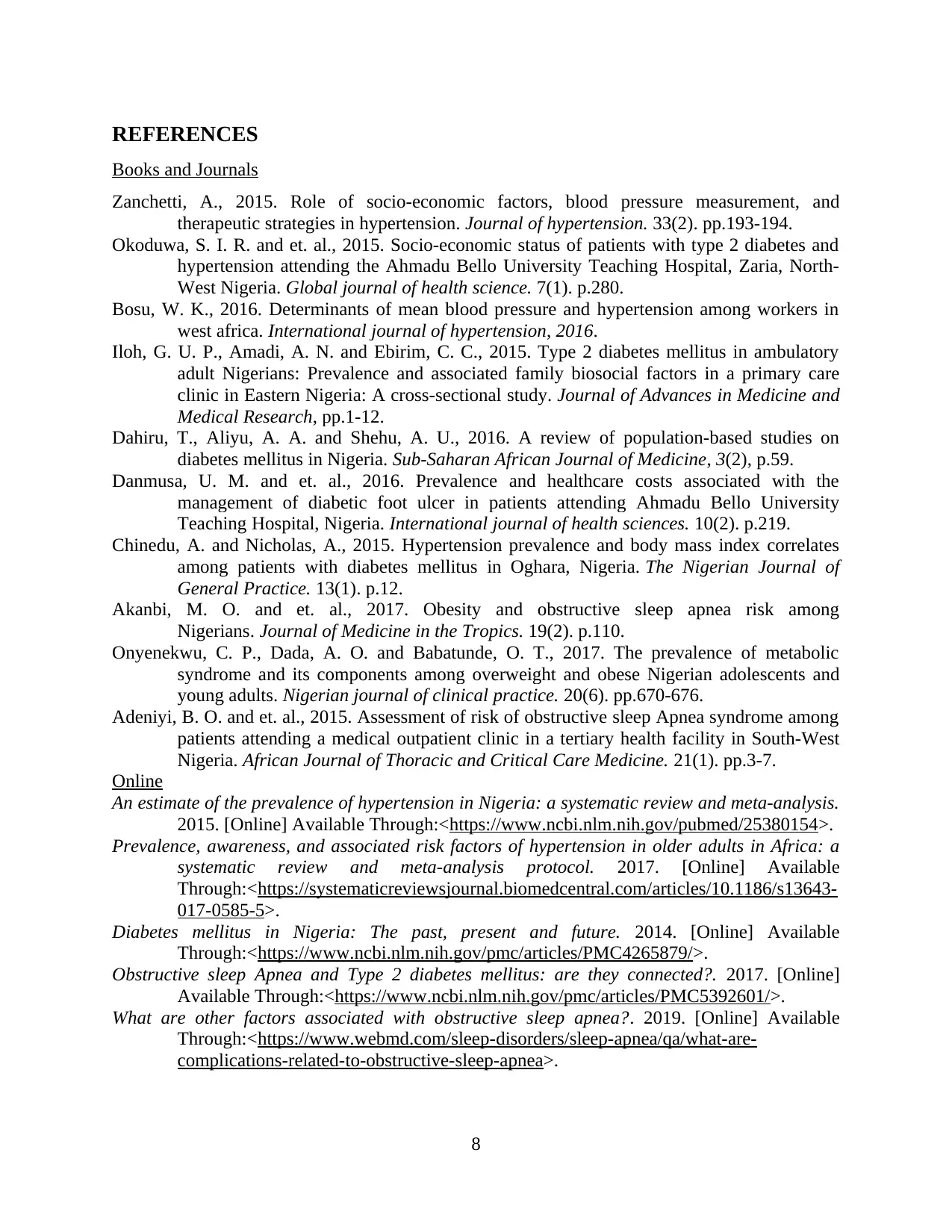
REFERENCES
Books and Journals
Zanchetti, A., 2015. Role of socio-economic factors, blood pressure measurement, and
therapeutic strategies in hypertension. Journal of hypertension. 33(2). pp.193-194.
Okoduwa, S. I. R. and et. al., 2015. Socio-economic status of patients with type 2 diabetes and
hypertension attending the Ahmadu Bello University Teaching Hospital, Zaria, North-
West Nigeria. Global journal of health science. 7(1). p.280.
Bosu, W. K., 2016. Determinants of mean blood pressure and hypertension among workers in
west africa. International journal of hypertension, 2016.
Iloh, G. U. P., Amadi, A. N. and Ebirim, C. C., 2015. Type 2 diabetes mellitus in ambulatory
adult Nigerians: Prevalence and associated family biosocial factors in a primary care
clinic in Eastern Nigeria: A cross-sectional study. Journal of Advances in Medicine and
Medical Research, pp.1-12.
Dahiru, T., Aliyu, A. A. and Shehu, A. U., 2016. A review of population-based studies on
diabetes mellitus in Nigeria. Sub-Saharan African Journal of Medicine, 3(2), p.59.
Danmusa, U. M. and et. al., 2016. Prevalence and healthcare costs associated with the
management of diabetic foot ulcer in patients attending Ahmadu Bello University
Teaching Hospital, Nigeria. International journal of health sciences. 10(2). p.219.
Chinedu, A. and Nicholas, A., 2015. Hypertension prevalence and body mass index correlates
among patients with diabetes mellitus in Oghara, Nigeria. The Nigerian Journal of
General Practice. 13(1). p.12.
Akanbi, M. O. and et. al., 2017. Obesity and obstructive sleep apnea risk among
Nigerians. Journal of Medicine in the Tropics. 19(2). p.110.
Onyenekwu, C. P., Dada, A. O. and Babatunde, O. T., 2017. The prevalence of metabolic
syndrome and its components among overweight and obese Nigerian adolescents and
young adults. Nigerian journal of clinical practice. 20(6). pp.670-676.
Adeniyi, B. O. and et. al., 2015. Assessment of risk of obstructive sleep Apnea syndrome among
patients attending a medical outpatient clinic in a tertiary health facility in South-West
Nigeria. African Journal of Thoracic and Critical Care Medicine. 21(1). pp.3-7.
Online
An estimate of the prevalence of hypertension in Nigeria: a systematic review and meta-analysis.
2015. [Online] Available Through:<https://www.ncbi.nlm.nih.gov/pubmed/25380154>.
Prevalence, awareness, and associated risk factors of hypertension in older adults in Africa: a
systematic review and meta-analysis protocol. 2017. [Online] Available
Through:<https://systematicreviewsjournal.biomedcentral.com/articles/10.1186/s13643-
017-0585-5>.
Diabetes mellitus in Nigeria: The past, present and future. 2014. [Online] Available
Through:<https://www.ncbi.nlm.nih.gov/pmc/articles/PMC4265879/>.
Obstructive sleep Apnea and Type 2 diabetes mellitus: are they connected?. 2017. [Online]
Available Through:<https://www.ncbi.nlm.nih.gov/pmc/articles/PMC5392601/>.
What are other factors associated with obstructive sleep apnea?. 2019. [Online] Available
Through:<https://www.webmd.com/sleep-disorders/sleep-apnea/qa/what-are-
complications-related-to-obstructive-sleep-apnea>.
8
Books and Journals
Zanchetti, A., 2015. Role of socio-economic factors, blood pressure measurement, and
therapeutic strategies in hypertension. Journal of hypertension. 33(2). pp.193-194.
Okoduwa, S. I. R. and et. al., 2015. Socio-economic status of patients with type 2 diabetes and
hypertension attending the Ahmadu Bello University Teaching Hospital, Zaria, North-
West Nigeria. Global journal of health science. 7(1). p.280.
Bosu, W. K., 2016. Determinants of mean blood pressure and hypertension among workers in
west africa. International journal of hypertension, 2016.
Iloh, G. U. P., Amadi, A. N. and Ebirim, C. C., 2015. Type 2 diabetes mellitus in ambulatory
adult Nigerians: Prevalence and associated family biosocial factors in a primary care
clinic in Eastern Nigeria: A cross-sectional study. Journal of Advances in Medicine and
Medical Research, pp.1-12.
Dahiru, T., Aliyu, A. A. and Shehu, A. U., 2016. A review of population-based studies on
diabetes mellitus in Nigeria. Sub-Saharan African Journal of Medicine, 3(2), p.59.
Danmusa, U. M. and et. al., 2016. Prevalence and healthcare costs associated with the
management of diabetic foot ulcer in patients attending Ahmadu Bello University
Teaching Hospital, Nigeria. International journal of health sciences. 10(2). p.219.
Chinedu, A. and Nicholas, A., 2015. Hypertension prevalence and body mass index correlates
among patients with diabetes mellitus in Oghara, Nigeria. The Nigerian Journal of
General Practice. 13(1). p.12.
Akanbi, M. O. and et. al., 2017. Obesity and obstructive sleep apnea risk among
Nigerians. Journal of Medicine in the Tropics. 19(2). p.110.
Onyenekwu, C. P., Dada, A. O. and Babatunde, O. T., 2017. The prevalence of metabolic
syndrome and its components among overweight and obese Nigerian adolescents and
young adults. Nigerian journal of clinical practice. 20(6). pp.670-676.
Adeniyi, B. O. and et. al., 2015. Assessment of risk of obstructive sleep Apnea syndrome among
patients attending a medical outpatient clinic in a tertiary health facility in South-West
Nigeria. African Journal of Thoracic and Critical Care Medicine. 21(1). pp.3-7.
Online
An estimate of the prevalence of hypertension in Nigeria: a systematic review and meta-analysis.
2015. [Online] Available Through:<https://www.ncbi.nlm.nih.gov/pubmed/25380154>.
Prevalence, awareness, and associated risk factors of hypertension in older adults in Africa: a
systematic review and meta-analysis protocol. 2017. [Online] Available
Through:<https://systematicreviewsjournal.biomedcentral.com/articles/10.1186/s13643-
017-0585-5>.
Diabetes mellitus in Nigeria: The past, present and future. 2014. [Online] Available
Through:<https://www.ncbi.nlm.nih.gov/pmc/articles/PMC4265879/>.
Obstructive sleep Apnea and Type 2 diabetes mellitus: are they connected?. 2017. [Online]
Available Through:<https://www.ncbi.nlm.nih.gov/pmc/articles/PMC5392601/>.
What are other factors associated with obstructive sleep apnea?. 2019. [Online] Available
Through:<https://www.webmd.com/sleep-disorders/sleep-apnea/qa/what-are-
complications-related-to-obstructive-sleep-apnea>.
8
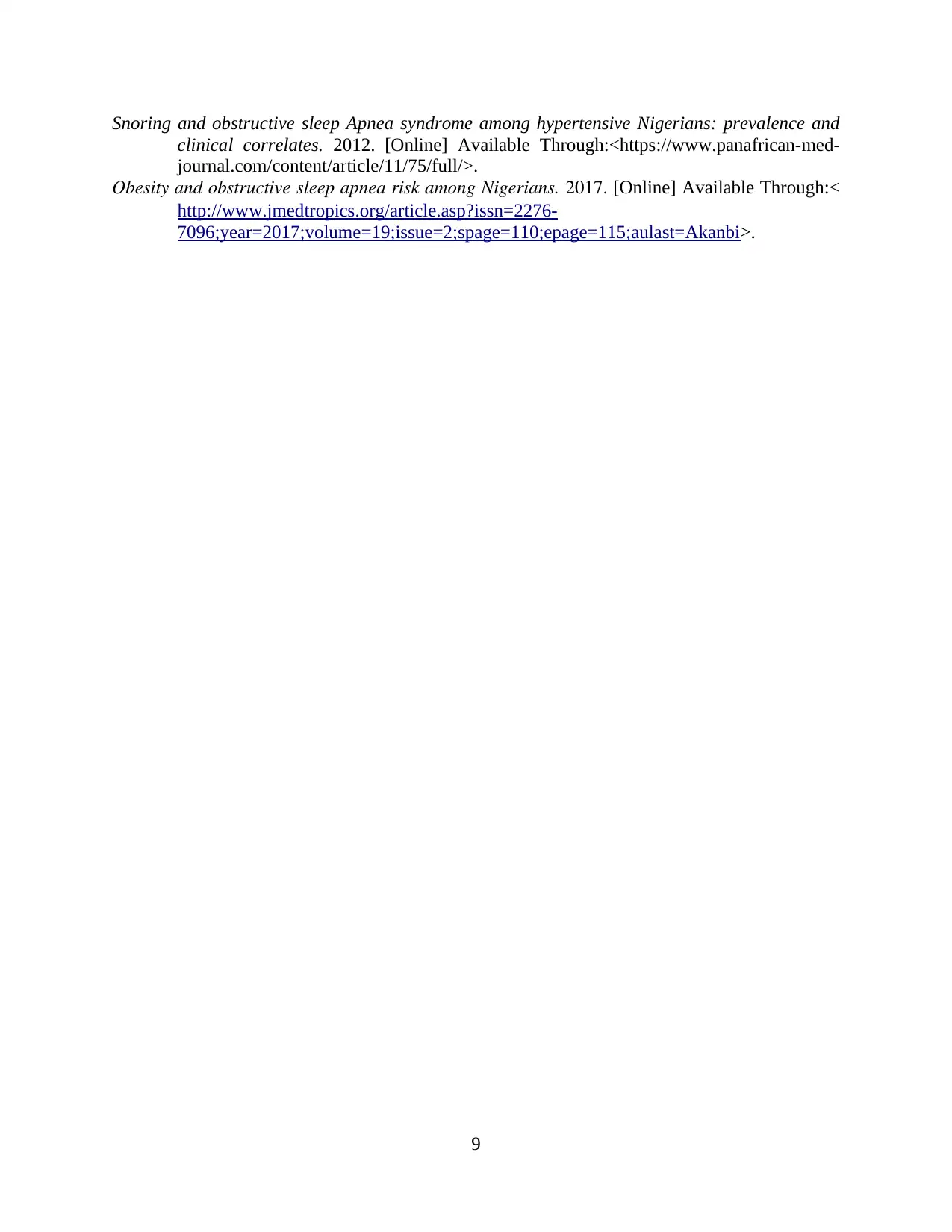
Snoring and obstructive sleep Apnea syndrome among hypertensive Nigerians: prevalence and
clinical correlates. 2012. [Online] Available Through:<https://www.panafrican-med-
journal.com/content/article/11/75/full/>.
Obesity and obstructive sleep apnea risk among Nigerians. 2017. [Online] Available Through:<
http://www.jmedtropics.org/article.asp?issn=2276-
7096;year=2017;volume=19;issue=2;spage=110;epage=115;aulast=Akanbi>.
9
clinical correlates. 2012. [Online] Available Through:<https://www.panafrican-med-
journal.com/content/article/11/75/full/>.
Obesity and obstructive sleep apnea risk among Nigerians. 2017. [Online] Available Through:<
http://www.jmedtropics.org/article.asp?issn=2276-
7096;year=2017;volume=19;issue=2;spage=110;epage=115;aulast=Akanbi>.
9
⊘ This is a preview!⊘
Do you want full access?
Subscribe today to unlock all pages.

Trusted by 1+ million students worldwide
1 out of 12
Related Documents
Your All-in-One AI-Powered Toolkit for Academic Success.
+13062052269
info@desklib.com
Available 24*7 on WhatsApp / Email
![[object Object]](/_next/static/media/star-bottom.7253800d.svg)
Unlock your academic potential
Copyright © 2020–2025 A2Z Services. All Rights Reserved. Developed and managed by ZUCOL.





